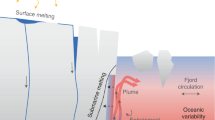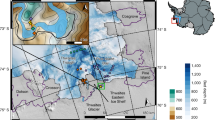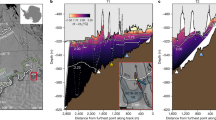Abstract
Widespread glacier acceleration has been observed in Greenland in the past few years1,2,3,4 associated with the thinning of the lower reaches of the glaciers as they terminate in the ocean5,6,7. These glaciers thin both at the surface, from warm air temperatures, and along their submerged faces in contact with warm ocean waters8. Little is known about the rates of submarine melting9,10,11 and how they may affect glacier dynamics. Here we present measurements of ocean currents, temperature and salinity near the calving fronts of the Eqip Sermia, Kangilerngata Sermia, Sermeq Kujatdleq and Sermeq Avangnardleq glaciers in central West Greenland, as well as ice-front bathymetry and geographical positions. We calculate water-mass and heat budgets that reveal summer submarine melt rates ranging from 0.7±0.2 to 3.9±0.8 m d−1. These rates of submarine melting are two orders of magnitude larger than surface melt rates, but comparable to rates of iceberg discharge. We conclude that ocean waters melt a considerable, but highly variable, fraction of the calving fronts of glaciers before they disintegrate into icebergs, and suggest that submarine melting must have a profound influence on grounding-line stability and ice-flow dynamics.
This is a preview of subscription content, access via your institution
Access options
Subscribe to this journal
Receive 12 print issues and online access
$259.00 per year
only $21.58 per issue
Buy this article
- Purchase on Springer Link
- Instant access to full article PDF
Prices may be subject to local taxes which are calculated during checkout



Similar content being viewed by others
References
Rignot, E. & Kanagaratnam, P. Changes in the velocity structure of the Greenland Ice Sheet. Science 311, 986–990 (2006).
Howat, I., Joughin, I. & Scambos, T. Rapid changes in ice discharge from Greenland outlet glaciers. Science 315, 1559–1561 (2007).
Luckman, A., Murray, T., de Lange, R. & Hanna, E. Rapid and synchronous ice-dynamic changes in East Greenland. Geophys. Res. Lett. 33, L03503 (2006).
Joughin, I., Abdalati, W. & Fahnestock, M. Large fluctuations in speed on Greenland’s Jakobshavn Isbrae glacier. Nature 432, 608–610 (2004).
Thomas, R. H. Force-perturbation analysis of recent thinning and acceleration of Jakobshavn Isbrae. Greenland J. Glaciol. 50, 57–66 (2004).
Thomas, R. H., Rignot, E., Kanagaratnam, P., Krabill, W. & Casassa, G. Force-perturbation analysis of Pine Island Glacier, Antarctica, suggests cause for recent acceleration. Ann. Glaciol. 39, 133–138 (2004).
Howat, I., Joughin, I., Tulaczyk, S. & Gogineni, S. Rapid retreat and acceleration of Helheim Glacier, East Greenland. Geophys. Res. Lett. 32, L22502 (2005).
Holland, D., Thomas, R. H., de Young, B. & Ribergaard, M. H. Acceleration of Jakobshavn Isbrae triggered by warm subsurface ocean waters. Nature Geosci. 1, 659–664 (2008).
Motyka, R., Hunter, L., Echelmeyer, K. & Connor, C. Submarine melting at the terminus of a temperate tidewater glacier, Leconte Glacier, Alaska, USA. Ann. Glaciol. 36, 57–65 (2003).
Walters, R., Josberger, E. G. & Driedger, C. L. Columbia Bay, Alaska: An upside down estuary. Estuarine, Coastal and Shelf. Science 26, 607–617 (1988).
Horne, E. P. Ice-induced vertical circulation in an Arctic fjord. J. Geophys. Res. 90, 1078–1086 (1985).
Box, J. et al. Greenland Ice Sheet surface mass balance variability (1988–2004) from calibrated polar MM5 output. J. Clim. 19, 2783–2800 (2006).
Hanna, E. et al. Increased runoff from melt from the Greenland Ice Sheet: A response to global warming. J. Clim. 21, 331–341 (2008).
Ettema, J. et al. Higher surface mass balance of the Greenland ice sheet revealed by high-resolution climate modelling. Geophys. Res. Lett. 36, L12501 (2009).
Rignot, E., Box, J. E., Burgess, E. & Hanna, E. Mass balance of the Greenland Ice Sheet from 1958 to 2007. Geophys. Res. Lett. 35, L20502 (2008).
Joughin, I. et al. Seasonal speedup along the western flank of the Greenland Ice Sheet. Science 320, 781–783 (2008).
Smith, W. H. F. & Sandwell, D. Global seafloor topography from satellite altimetry and ship depth soundings. Science 277, 1957–1962 (1997).
Holland, P., Jenkins, A. & Holland, D. The response of ice shelf basal melting to variations in ocean temperature. J. Clim. 21, 2558–2572 (2008).
Rignot, E. & Jacobs, S. S. Rapid bottom melting widespread near Antarctic Ice Sheet grounding lines. Science 296, 2020–2023 (2002).
Warren, C. R. Terminal environment, topographic control and fluctuations of West Greenland glaciers. Boreas 20, 1–15 (1991).
Sohn, H. G., Jezek, K. & van der Veen, C. Jakobshavn Glacier, West Greenland: 30 years of spaceborne observations. Geophys. Res. Lett. 25, 2699–2702 (1998).
Padman, L. & Erofeeva, S. A barotopic inverse tidal model for the Arctic Ocean. Geophys. Res. Lett. 31, L02303 (2004).
Acknowledgements
This work was carried out at the Earth System Science Department of Physical Sciences, University of California, Irvine and at the California Institute of Technology’s Jet Propulsion Laboratory under a contract with the National Aeronautics and Space Administration’s Cryospheric Science Program. We thank B. Hallet, K. Steffen, E. Domack and S. Tulacyk for their generous loan of oceanographic equipment used, and J. Box and J. Ettema for providing estimates of summer 2008 runoff.
Author information
Authors and Affiliations
Contributions
All authors discussed the results and commented on the manuscript. E.R. led the analysis, development of the paper and integration of the results with other data. M.K. analysed the ocean data and the ice-front bathymetry. I.V. helped collect and analyse the ocean data.
Corresponding author
Ethics declarations
Competing interests
The authors declare no competing financial interests.
Supplementary information
Supplementary Information
Supplementary Information (PDF 426 kb)
Rights and permissions
About this article
Cite this article
Rignot, E., Koppes, M. & Velicogna, I. Rapid submarine melting of the calving faces of West Greenland glaciers. Nature Geosci 3, 187–191 (2010). https://doi.org/10.1038/ngeo765
Received:
Accepted:
Published:
Issue Date:
DOI: https://doi.org/10.1038/ngeo765
This article is cited by
-
Subsurface ocean warming preceded Heinrich Events
Nature Communications (2022)
-
Subglacial discharge controls seasonal variations in the thermal structure of a glacial lake in Patagonia
Nature Communications (2021)
-
Temporal Changes Over Major Antarctic Ice Shelve Margins During 2001–2016
Journal of the Indian Society of Remote Sensing (2020)
-
Ocean contributes to the melting of the Jakobshavn Glacier front
Science China Earth Sciences (2020)
-
Rapid iceberg calving following removal of tightly packed pro-glacial mélange
Nature Communications (2019)



